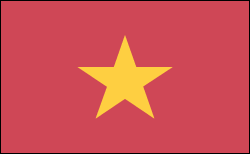Vietnam News & Current Events


Vietnam Splits North and South; America Enters the War
A bitter defeat at Dien Bien Phu in northwest Vietnam on May 5, 1954, broke the French military campaign and resulted in the division of Vietnam. In the new South, Ngo Dinh Diem, prime minister under Bao Dai, deposed the monarch in 1955 and made himself president. Diem used strong U.S. backing to create an authoritarian regime that suppressed all opposition but could not eradicate the Northern-supplied Communist Viet Cong.
Skirmishing grew into a full-scale war, with escalating U.S. involvement. A military coup, U.S.-inspired in the view of many, ousted Diem on Nov. 1, 1963, and a kaleidoscope of military governments followed. The most savage fighting of the war occurred in early 1968 during the Vietnamese New Year, known as Tet. Although the so-called Tet Offensive ended in a military defeat for the North, its psychological impact changed the course of the war.
U.S. bombing and an invasion of Cambodia in the summer of 1970—an effort to destroy Viet Cong bases in the neighboring state—marked the end of major U.S. participation in the fighting. Most American ground troops were withdrawn from combat by mid-1971 when the U.S. conducted heavy bombing raids on the Ho Chi Minh Trail—a crucial North Vietnamese supply line. In 1972, secret peace negotiations led by Secretary of State Henry A. Kissinger took place, and a peace settlement was signed in Paris on Jan. 27, 1973.
By April 9, 1975, Hanoi's troops marched within 40 miles of Saigon, the South's capital. South Vietnam's president Thieu resigned on April 21 and fled. Gen. Duong Van Minh, the new president, surrendered Saigon on April 30, ending a war that claimed the lives of 1.3 million Vietnamese and 58,000 Americans.
Border Clashes With Cambodia Continue
In 1977, border clashes between Vietnam and Cambodia intensified, as well as accusations by its former ally Beijing that Chinese residents of Vietnam were being subjected to persecution. Beijing cut off all aid and withdrew 800 technicians.
Hanoi was also preoccupied with a continuing war in Cambodia, where 60,000 Vietnamese troops had invaded and overthrown the country's Communist leader Pol Pot and his pro-Chinese regime. In early 1979, Vietnam was conducting a two-front war: defending its northern border against a Chinese invasion and supporting its army in Cambodia, which was still fighting Pol Pot's Khmer Rouge guerrillas. Hanoi's Marxist policies combined with the destruction of the country's infrastructure during the decades of fighting devastated Vietnam's economy. However, it started to pick up in 1986 under doi moi (economic renovation), an effort at limited privatization. Vietnamese troops began limited withdrawals from Laos and Cambodia in 1988, and Vietnam supported the Cambodian peace agreement signed in Oct. 1991.
Relations with America Improve as the Vietnamese Economy Reforms
The U.S. lifted a Vietnamese trade embargo in Feb. 1994 that had been in place since U.S. involvement in the war. Full diplomatic relations were announced between the two countries in July 1995. In April 1997, a pact was signed with the U.S. concerning repayment of the $146 million wartime debt incurred by the South Vietnamese government, and the following year the nation began a drive to eliminate inefficient bureaucrats and streamline the approval process for direct foreign investment. Efforts of reform-minded officials toward political and economic change have been thwarted by Vietnam's ruling Communist Party. In April 2001, however, the progressive Nong Duc Manh was appointed general secretary of the ruling Communist Party, succeeding Le Kha Phieu. Even with a reformer at the helm of the party, change has been slow and cautious.
In Nov. 2001, Vietnam's national assembly approved a trade agreement that opened U.S. markets to Vietnam's goods and services. Tariffs on Vietnam's products dropped to about 4% from rates as high as 40%. Vietnam in return opened its state markets to foreign competition.
The government highlighted its efforts to crack down on corruption and crime with the June 2003 conviction of notorious criminal syndicate boss Truong Van Cam, known as Nam Cam. He was sentenced to death, along with 155 other defendants, and executed in June 2004.
Prime Minister Phan Van Khai visited the United States in June 2005, becoming the first Vietnamese leader to do so since the Vietnam War ended. He met with President Bush and several business leaders, including Microsoft chairman Bill Gates. The U.S. is Vietnam's largest trading partner, buying about $7 billion in Vietnamese goods each year.







